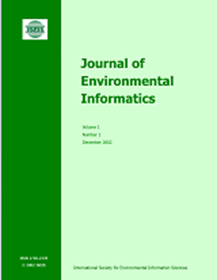Improvement of Instantaneous Point Source Model for Simulating Radionuclide Diffusion in Oceans under Nuclear Power Plant Accidents
IF 5.4
1区 环境科学与生态学
Q1 ENVIRONMENTAL SCIENCES
引用次数: 10
Abstract
Simulation methods have become an important tool to reveal radionuclide migration during accidental radionuclide releases and predict influences of accidents on the marine environment. The instantaneous point source model is a useful method to simulate the large-scale radionuclide diffusion in marine areas. However, the simulation accuracy of this method requires improvement as it didn’t take radionuclide decay into account. In this study, an improved instantaneous point source model considering radionuclide decay was proposed on the basis of the original model. Furthermore, the instantaneous point source model and the improved version were used to simulate the concentrations of 131I and 137Cs following the Fukushima Dai-ichi nuclear power plant accident. The results showed that the relative error of 131I concentrations decreased from 136.03% to 37.59% when using the improved model; and improvements in relative errors for 137Cs concentrations were not apparent as the simualtion period was much shorter than its half-life period. Therefore, the improved model can accurately simulate the diffusion process for radionuclides following an accident and provides an efficient decision support tool for risk assessment managers and for use in safety guarantees of nuclear power plants during siting and operational phases.核电厂事故下海洋放射性核素扩散瞬点源模型的改进
模拟方法已成为揭示放射性核素事故释放过程中放射性核素迁移和预测事故对海洋环境影响的重要工具。瞬态点源模型是模拟海洋区域大规模放射性核素扩散的一种有效方法。但由于该方法没有考虑放射性核素衰变,其模拟精度有待提高。本文在原模型的基础上,提出了一种考虑放射性核素衰变的改进瞬时点源模型。利用瞬时点源模型和改进模型对福岛第一核电站事故后的131I和137Cs浓度进行了模拟。结果表明:采用改进模型后,131I浓度的相对误差从136.03%降低到37.59%;137Cs浓度的相对误差改善不明显,因为模拟周期远短于其半衰期。因此,改进后的模型可以准确地模拟事故发生后放射性核素的扩散过程,为风险评估管理者提供有效的决策支持工具,并可用于核电厂选址和运行阶段的安全保障。
本文章由计算机程序翻译,如有差异,请以英文原文为准。
求助全文
约1分钟内获得全文
求助全文
来源期刊

Journal of Environmental Informatics
ENVIRONMENTAL SCIENCES-
CiteScore
12.40
自引率
2.90%
发文量
7
审稿时长
24 months
期刊介绍:
Journal of Environmental Informatics (JEI) is an international, peer-reviewed, and interdisciplinary publication designed to foster research innovation and discovery on basic science and information technology for addressing various environmental problems. The journal aims to motivate and enhance the integration of science and technology to help develop sustainable solutions that are consensus-oriented, risk-informed, scientifically-based and cost-effective. JEI serves researchers, educators and practitioners who are interested in theoretical and/or applied aspects of environmental science, regardless of disciplinary boundaries. The topics addressed by the journal include:
- Planning of energy, environmental and ecological management systems
- Simulation, optimization and Environmental decision support
- Environmental geomatics - GIS, RS and other spatial information technologies
- Informatics for environmental chemistry and biochemistry
- Environmental applications of functional materials
- Environmental phenomena at atomic, molecular and macromolecular scales
- Modeling of chemical, biological and environmental processes
- Modeling of biotechnological systems for enhanced pollution mitigation
- Computer graphics and visualization for environmental decision support
- Artificial intelligence and expert systems for environmental applications
- Environmental statistics and risk analysis
- Climate modeling, downscaling, impact assessment, and adaptation planning
- Other areas of environmental systems science and information technology.
 求助内容:
求助内容: 应助结果提醒方式:
应助结果提醒方式:


